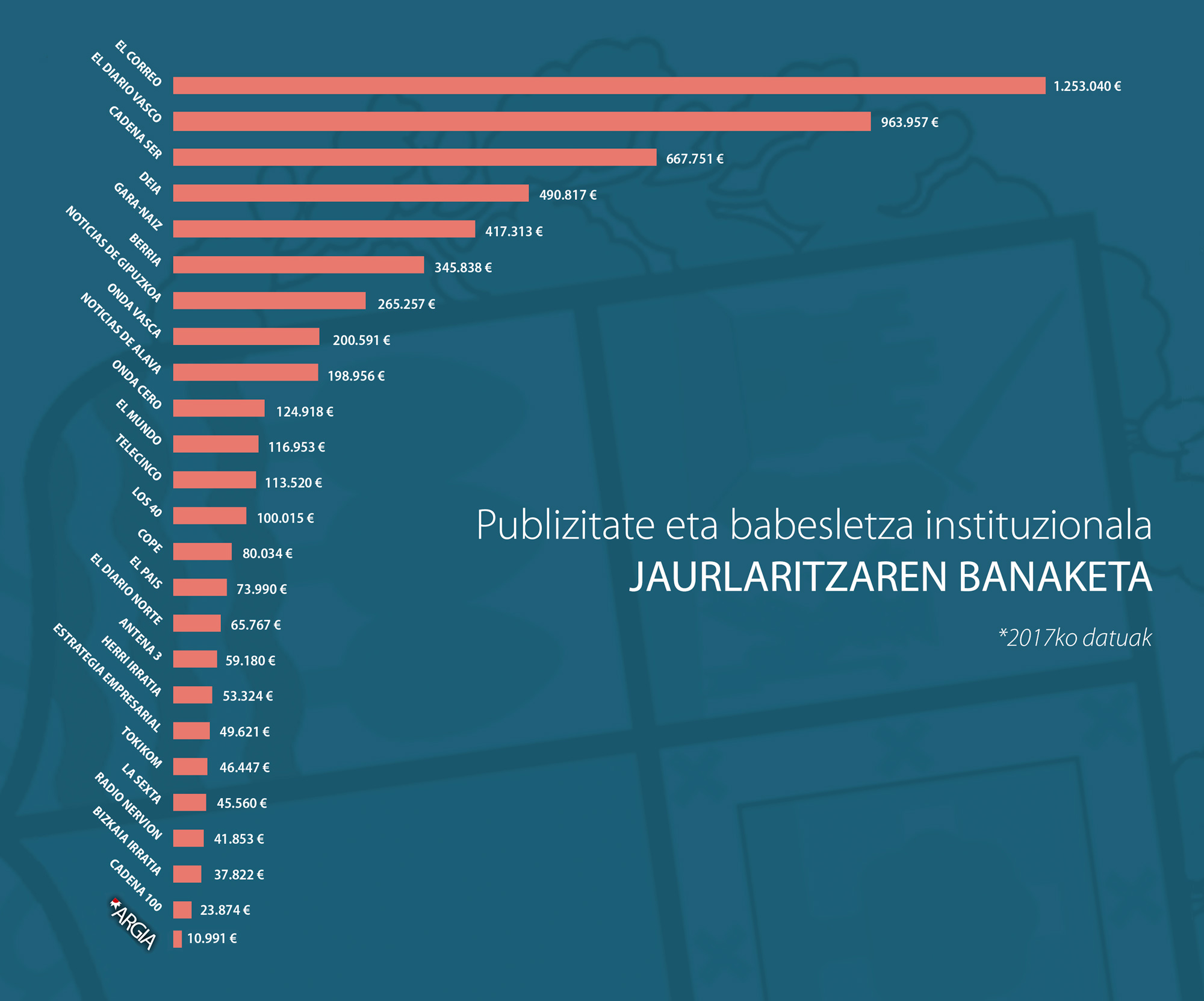Advertising of the Provincial Council of Álava: where does the public money go?
- Which media receives the most public money through advertising? Hala Bedi analyzes the media in which the Provincial Council of Álava invests advertising. It is dominated by El Correo de Álava, which receives 31.8% of the advertising, while the media mainly dedicated to the Basque language receives 7.4% of the total.

The institutions dedicate thousands of euros each year to advertising to inform their campaigns, news or political propaganda. This is not new: public money is usually used for institutional interest by municipalities, provincial councils or the Basque Government. The Provincial Council of Álava, for example, spent 594,718.79 euros on this task in 2017. We are talking about advertising bought in the media to advertise, among others, ‘Arabarra of the Month’, ‘Renta’, ‘San Prudencio’ or ‘Copa del Rey’. The purpose of this report is to shed light on the public money that is being hidden from us as citizens.

The Mayor of El Correo
de Álava, Noticias de Álava, has closely allocated 31.8% of the money invested in advertising by the Provincial Council of Álava (189,475.35 euros) to the newspaper El Correo de Álava in 2017. He owns El Correo in the country because, among other things, it is the media that receives the most money in advertising and other subsidies. To give an example, although El Correo reports in Spanish, it is the media in Álava that has received the most money for “promoting Basque on the net”: In 2017, the Basque Government donated €73,000, the same amount that was donated to Berria for the same reason.
On average, Noticias de Álava sells 3,343 daily newspapers, far from the 12,144 copies that El Correo sells in Álava. However, as far as the money received from advertising in the Provincial Council of Álava is concerned, there is not so much difference between the two. In 2017, the newspaper of Noticias and Vocento received 116,213 euros with 189,475 euros. In the name of scope it is difficult to understand, but it is even more complicated to understand why these two newspapers receive 51% of the total advertising of the Provincial Council of Álava: More than $300,000.

Underestimation of the
Basque media The data speak clearly: Only 7.4% of the money spent on advertising by the Provincial Council of Álava is received by media mainly dedicated to the Basque language.
Alava, Aiaraldea and Luz have received less than 15,000 euros, less than the amount received by the radio station Onda Cero alone. And this, just an example da.Beste an example: All the media mainly dedicated to the Basque language receive much less money than El Correo de Álava (7.4%), the newspaper of the group Vocento won 31.8% of the money. Divided into two groups, EITB Raíces, Noticias, Claras, Aiaraldea, Alava Ale, Aitzina Folk, Hamaika TB and Gorbeiaberria together quadruple the amount of SOS received by El Correo de Álava alone.
Another noteworthy fact is this: A Basque media outlet that extends throughout the territory of Álava (such as Alea de Álava) receives less money than other media outlets operating in a smaller area. Even if the criterion for the distribution of advertising depended on its scope, the reason for the difference would not be understood.

And the other institutions?
This data is only a small part of what the media receives from advertising. To take a complete picture, it is essential to take into account the money that goes from the advertising of the other public institutions: municipalities, the Basque Government, public companies, the Spanish Government, etc. The business groups that make up the best-selling newspapers, televisions and radio stations in Álava receive millions each year from the public fund, without clear criteria and in an opaque way, through advertising, sponsorship, technical work and subsidies.

*NOTE: NOTE: Hala Bedi does not advertise. Hala Bedi’s intention in publishing this news is not to start receiving advertising money. With regard to the distribution of public money, we wish to denounce the gap between the Basque and popular media and the media that
are mainly Spanish.
This news has been published by the radio station Hala Bedi and we have brought it to LUZ thanks to the license CC-by-sa.
Hedabide euskaldunak biltzen dituen Hekimen elkarteak bilera eskatu dio Gipuzkoako Foru Aldundiari, erakunde horrek iragarritako publizitate instituzionalaren beherakada aztertzeko. 2015eko aurrekontuarekin alderatuta, erdira jaitsiko du euskarazko hedabideetako publizitatea... [+]




















